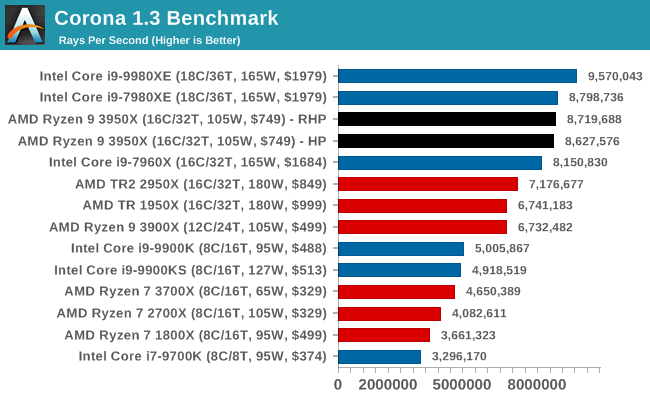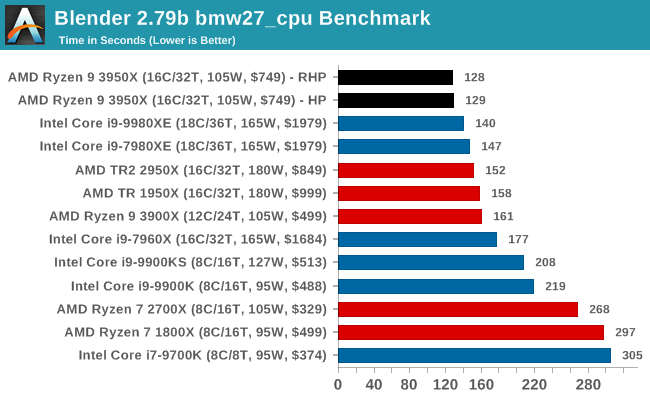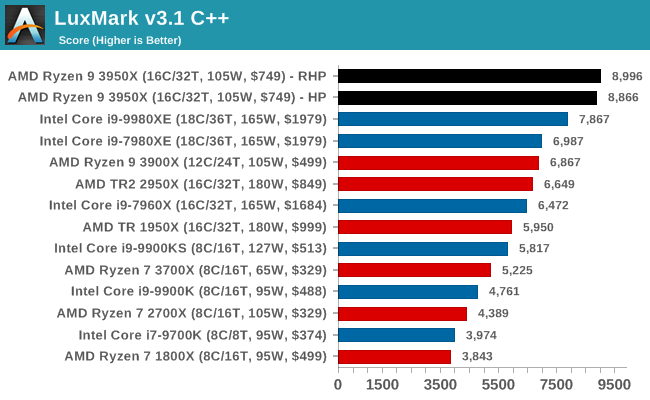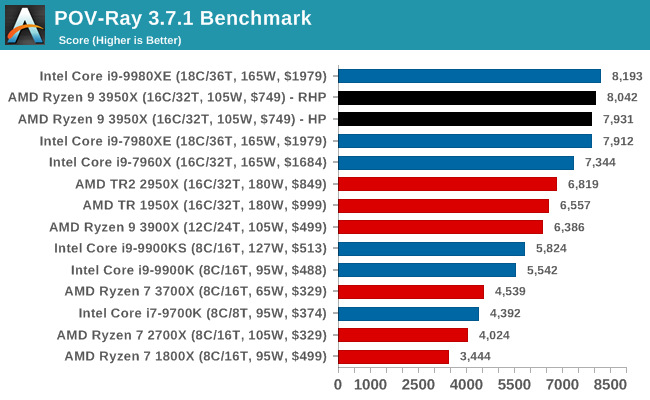The AMD Ryzen 9 3950X Review: 16 Cores on 7nm with PCIe 4.0
by Dr. Ian Cutress on November 14, 2019 9:00 AM ESTCPU Performance: Rendering Tests
Rendering is often a key target for processor workloads, lending itself to a professional environment. It comes in different formats as well, from 3D rendering through rasterization, such as games, or by ray tracing, and invokes the ability of the software to manage meshes, textures, collisions, aliasing, physics (in animations), and discarding unnecessary work. Most renderers offer CPU code paths, while a few use GPUs and select environments use FPGAs or dedicated ASICs. For big studios however, CPUs are still the hardware of choice.
All of our benchmark results can also be found in our benchmark engine, Bench.
Corona 1.3: Performance Render
An advanced performance based renderer for software such as 3ds Max and Cinema 4D, the Corona benchmark renders a generated scene as a standard under its 1.3 software version. Normally the GUI implementation of the benchmark shows the scene being built, and allows the user to upload the result as a ‘time to complete’.
We got in contact with the developer who gave us a command line version of the benchmark that does a direct output of results. Rather than reporting time, we report the average number of rays per second across six runs, as the performance scaling of a result per unit time is typically visually easier to understand.
The Corona benchmark website can be found at https://corona-renderer.com/benchmark

Intel's HEDT chips are quite good at Corona, but if we compare the 3900X to the 3950X, we still see some good scaling.
Blender 2.79b: 3D Creation Suite
A high profile rendering tool, Blender is open-source allowing for massive amounts of configurability, and is used by a number of high-profile animation studios worldwide. The organization recently released a Blender benchmark package, a couple of weeks after we had narrowed our Blender test for our new suite, however their test can take over an hour. For our results, we run one of the sub-tests in that suite through the command line - a standard ‘bmw27’ scene in CPU only mode, and measure the time to complete the render.
Blender can be downloaded at https://www.blender.org/download/

AMD is taking the lead in our blender test, with the 16-core chips easily going through Intel's latest 18-core hardware.
LuxMark v3.1: LuxRender via Different Code Paths
As stated at the top, there are many different ways to process rendering data: CPU, GPU, Accelerator, and others. On top of that, there are many frameworks and APIs in which to program, depending on how the software will be used. LuxMark, a benchmark developed using the LuxRender engine, offers several different scenes and APIs.
In our test, we run the simple ‘Ball’ scene on both the C++ code path, in CPU mode. This scene starts with a rough render and slowly improves the quality over two minutes, giving a final result in what is essentially an average ‘kilorays per second’.

Despite using Intel's Embree engine, again AMD's 16-cores easily win out against Intel's 18-core chips, at under half the cost.
POV-Ray 3.7.1: Ray Tracing
The Persistence of Vision ray tracing engine is another well-known benchmarking tool, which was in a state of relative hibernation until AMD released its Zen processors, to which suddenly both Intel and AMD were submitting code to the main branch of the open source project. For our test, we use the built-in benchmark for all-cores, called from the command line.
POV-Ray can be downloaded from http://www.povray.org/

POV-Ray ends up with AMD 16-core splitting the two Intel 18-core parts, which means we're likely to see the Intel Core i9-10980XE at the top here. It would have been interesting to see where an Intel 16-core Core-X on Cascade would end up for a direct comparison, but Intel has no new 16-core chip planned.











206 Comments
View All Comments
FreckledTrout - Thursday, November 14, 2019 - link
While I cant argue that Intel 7nm chips will destroy AMD's current chips. However you are talking two generations of process that need to come out for Intel so at best end of 2021 but more likely in 2022. AMD will either be on or just about ready to release chips on 5nm by the time Intel has chips on 7nm so I expect no destroying from either side but instead healthy competition.Oliseo - Thursday, November 14, 2019 - link
Had to sit down after reading that. A sensible comment on the Internet.Faith in humanity restored.
abufrejoval - Friday, November 15, 2019 - link
Was sitting already, but you made me smile :-)brantron - Thursday, November 14, 2019 - link
Intel's priority #1 for 7nm also may not be a new CPU architecture. GPU comes first. Willow Cove derivatives could very well appear on 14nm, 10nm, and then wait until 7nm+.And there could also be a 14nm Double Plus Good process. :p
Teckk - Thursday, November 14, 2019 - link
Not sure if you intended to reply to me 🤔 I'm already of the opinion there's no destroying anyone anytime soonIrata - Thursday, November 14, 2019 - link
You could argue that prior to Ryzen 3000, Intel was on the better process (14nm ++... vs. GloFo 14nm and 12nm). And they did not exactly destroy Ryzen / Threadripper back then.Not saying this would not help them if they were on 7nm right now, but considering the impressive manner in which Intel's engineers have tweaked 14nm, the difference in performance may be smaller than expected.
nico_mach - Thursday, November 14, 2019 - link
… Except everyone insists that Intel's 10nm IS equivalent to everyone else's 7nm. But sure, next process they'll destroy the competition, any year now.GraveNoX - Thursday, November 14, 2019 - link
Equivalent in what ? Is like saying all diesel cars will have the same performance.Oliseo - Thursday, November 14, 2019 - link
"Everyone in my imagination insists Intel will destroy AMD. And the voices in my head don't lie"lobz - Thursday, November 14, 2019 - link
I'm sure they all mean: any decade now :)